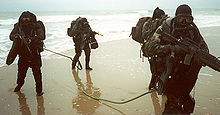
Amphibious reconnaissance consists of ground and naval reconnaissance in the littoral area bordering coastal or ocean areas.

Amphibious reconnaissance consists of ground and naval reconnaissance in the littoral area bordering coastal or ocean areas.
At the turn of the 20th century, amphibious reconnaissance was first conceived from an idea from a United States Marine officer by then-Major Dion Williams. Williams referenced the purpose of amphibious reconnaissance by standardizing the 'official' naval doctrine of amphibious reconnaissance [1] of American amphibious warfare in 1906. The scope of the doctrine outlined every aspect that involved recognition of intelligence gathering and planning, the cornerstone of America's present-day methods in amphibious reconnaissance. [2]
By 1933 the Fleet Marine Force was formed at Headquarters Marine Corps at Marine Corps Base Quantico, combining the roles of the United States Navy and United States Marine Corps into an integrated naval assault force. Shortly after, a new doctrine, the Fleet Training Publication 167 [3] was created.
With this new amphibious reconnaissance doctrine, the United States Navy and Marine Corps began to consider establishing reconnaissance units. T [4] [5] Williams had specified in his thesis that "...talented and experienced men should be assigned to this work, listing among the requisite qualities a thorough technical knowledge, a quick and energetic nature to ensure the work is accomplished without unnecessary delay, a sufficient resourcefulness to overcome unexpected obstacles, a reticence to ensure results are kept confidential, and above all, exactitude of work". [5]
These Marines particularly needed to be competent in surveying, cartography, and recording observations, as well as reading previous maps and surveys of various types.
Williams' doctrine outlined a wide spectrum of reconnaissance, which consisted of range determination, topography, configuration of the ground, cities, towns, roads, trails, railroads, telegraph cables, telephone lines, wireless telegraphy, rivers, canals, resources (coal, repair facilities, land transportation, electric plants, food supplies, water supply, and hospitals), conditions of the harbor and harbor steamers, wharves, docks, water service, the population (secret service, professions and occupations, naval and military forces), existing defenses (location, form and description, armament, fieldworks, mines and mine fields, searchlights, plans and sketches, garrisons and forces available, methods of attack, adaptability of the defenses). [4]
In order to prepare intelligent plans for the attack or defense of a harbor or bay, it is necessary to have at hand a comprehensive description of the hydrographic features and accurate charts showing the depths of water at all points, the reefs, rocks, shoals, and peculiar currents which constitute dangers to navigation, and the tributary streams and channels which may form avenues of attack or furnish anchorages for a portion of the floating defenses or auxiliaries of the defenders. [5]
There were three significant aspects of Williams' Naval Reconnaissance: [6] (1) discussion of additional capabilities of observation from airplanes and submarines, (2) promulgation of the book under authority of the Secretary of the Navy instead of under the auspices of the President of the Naval War College, and (3) emphasis on information acquisition for long-term planning. [4] It was this latter emphasis on obtaining information long before hostilities that was perhaps of greatest significance. Rather than obtaining information solely for military operations in progress, Williams now enunciated a more comprehensive mission: [4]
The object of the naval reconnaissance of any given locality is to acquire all of the information concerning the sea, land, air and material resources of that locality, with a view to its use by the Navy in peace and war, and to record this information that it may be most readily available for: the preparation of plans for the occupation of the locality as a temporary or permanent naval base; the preparation of plans for the sea and land defense of the locality when used as such a base; or the preparation of plans for the attack of the locality by sea and land should it be in possession of an enemy. [6]
Twenty years later, another Marine Intelligence Officer, Earl H. Ellis, put most of William's concept to effect. [7] After fighting in the trenches in World War I, Ellis submitted a request to Headquarters Marine Corps for special intelligence duty in South America and the Pacific; the Director of Naval Intelligence accepted. Ellis submitted a 30,000 page Top Secret document [8] concerning the local sea, air and climate, various land terrain types, the native population and economic conditions, reports on strategically seizing key islands as forward-operating bases, time-tables, mobilization projections, and predictions of manpower necessary to seize certain targets.
Most of these duties were billeted by senior Naval Intelligence Officers that were trained in topography, hydrography, and construction of fortifications. [9]
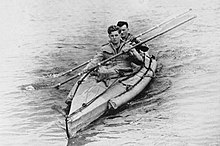
The development of amphibious reconnaissance in the early stages of the Second World War during the European campaigns were largely dominated by Lt. Commander Nigel Clogstoun-Willmot RN, who developed what would become the Combined Operations Pilotage Parties (COPPs) while conducting raids on the Aegean Islands in 1941. [10] Following Operation Torch, which was carried out without proper reconnaissance[ according to whom? ], it was proposed that 50 of these parties would be needed; however, the shortage of necessary personnel meant that in all only eleven teams were trained. [11] The Beach Pilotage School was set up on the Kyles of Bute in Scotland.
The COPP Depot[ clarification needed ] was set up in 1943 on Hayling Island [12] based at Hayling Island Sailing Club. In preparation for the invasion of Normandy, the British carried out Operation Postage Able, in which a midget submarine took a team close in to the planned landing sites. The team took samples from the beach to determine its ability to bear vehicles, and, together with depth soundings and other observations, large-scale models of the beaches were constructed to aid planning. In addition, American combat swimmer teams from Naval Combat Demolition Units conducted nighttime reconnaissance on possible landing sites, mapping underwater obstacles and helping to clear obstacles during the invasion. [13]
Following the war, the secrecy surrounding beach recce continued, and mention of the COPPs did not appear in the press until the late 1950s. By then their knowledge and role had been passed on to the (then) Special Boat Squadron. [14]

Force Reconnaissance (FORECON) are United States Marine Corps deep reconnaissance companies that supply military intelligence to the command element of the Marine Air-Ground Task Force (MAGTF). Force Reconnaissance companies unlike USMC division reconnaissance report to the Marine expeditionary force (MEF) and provide direct action and deep reconnaissance during large-scale operations.
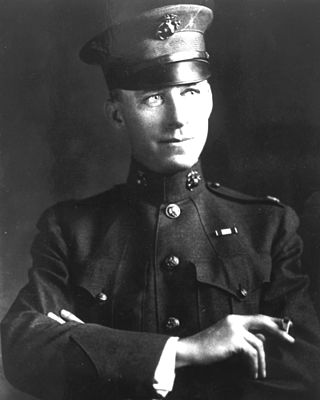
Lieutenant Colonel Earl Hancock "Pete" Ellis was a United States Marine Corps Intelligence Officer, and author of Operations Plan 712: Advanced Base Operations in Micronesia, which became the basis for the American campaign of amphibious assault that defeated the Japanese in World War II.

The Marine Corps Special Operations Command Detachment One, also simply known as Det One, was a pilot program of attaching a permanent unit of the United States Marine Corps to the United States Special Operations Command. It was commanded by Col. Robert J. Coates, former commanding officer of 1st Force Reconnaissance Company. Det One was activated on 19 June 2003 and had its headquarters at Camp Del Mar Boat Basin in Camp Pendleton, California. It was disbanded in 2006 and succeeded by the permanent United States Marine Corps Forces Special Operations Command (MARSOC).
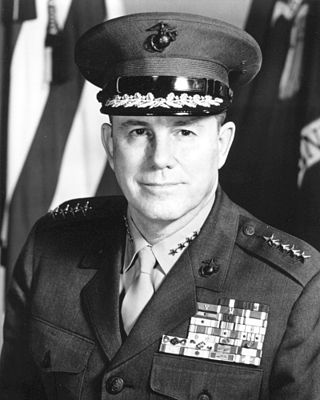
Robert Everton Cushman Jr. was a United States Marine Corps four-star general who served as the 25th commandant of the Marine Corps from January 1, 1972, to June 30, 1975. He was honored for heroism during World War II at the battles of Guam, Bougainville and Iwo Jima. He also commanded all Marine forces in the Vietnam War from June to December 1967, and served as deputy director of the Central Intelligence Agency (CIA) from 1969 to 1971.
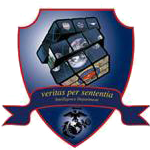
The Marine Corps Intelligence is the intelligence arm of the United States Marine Corps (USMC) and an element of the United States Intelligence Community. The Director of Intelligence supervises the Intelligence Department of HQMC and is responsible for policy, plans, programming, budgets, and staff supervision of Intelligence and supporting activities within the U.S. Marine Corps as well as supervising the Marine Corps Intelligence Activity (MCIA). The department supports the Commandant of the Marine Corps (CMC) in his role as a member of the Joint Chiefs of Staff (JCS), represents the service in Joint and Intelligence Community matters, and exercises supervision over the MCIA.

The Marine Corps Systems Command (MCSC) is the acquisition command of the United States Marine Corps, made up of Marines, sailors, civilians and contractors. As the only systems command in the Marine Corps, MCSC serves as Head of Contracting Authority and exercises technical authority for all Marine Corps ground weapon and information technology programs. MCSC is headquartered at Marine Corps Base Quantico.

Charles Elliott Wilhelm is a decorated retired United States Marine Corps General who served two combat tours of duty in Vietnam. He later served as Commanding General of the 1st Marine Division; as a Deputy Assistant Secretary of Defense; and as the Commander, U.S. Southern Command (1997–2000). General Wilhelm retired from the Marine Corps in 2000, after 37 years of service.

The United States Marine Corps (USMC), also referred to as the United States Marines, is the maritime land force service branch of the United States Armed Forces responsible for conducting expeditionary and amphibious operations through combined arms, implementing its own infantry, artillery, aerial, and special operations forces. The U.S. Marine Corps is one of the eight uniformed services of the United States.
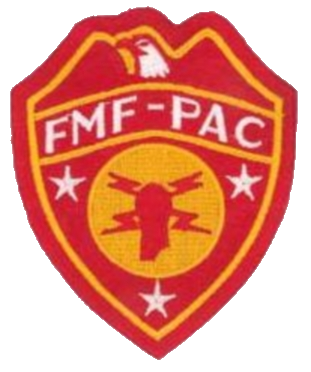
The United States Marine Corps's Amphibious Reconnaissance Battalion, formerly Company, was a Marine Corps special operations forces of United States Marine and Hospital corpsman that performed clandestine operation preliminary pre–D-Day amphibious reconnaissance of planned beachheads and their littoral area within uncharted enemy territory for the joint-Navy/Marine force commanders of the Pacific Fleet during World War II. Often accompanied by Navy Underwater Demolition Teams and the early division recon companies, these amphibious recon platoons performed more reconnaissance missions than any other single recon unit during the Pacific campaigns.
The United States Marine Corps's Advanced Base Force was a coastal and naval base defense force that was designed to set up mobile and fixed bases in the event of major landing operations within, and beyond, the territorial United States. Established in the beginning of the 20th century, the Advanced Base Force was the United States' first combined task force built on the concept of the Marine Corps' traditional role in expeditionary warfare. The slow development of the advanced base force played a significant role in the controversy over the removal of the ships' guards in 1908–1909.
The Fleet Landing Exercises, or FLEX were amphibious landing exercises conducted by the United States Navy and United States Marine Corps between 1935 and 1941. The purpose of these exercises was to formulate a workable amphibious warfare doctrine. The development of the necessary craft and other equipment, and the proper tactical deployment of them were also results. Finally, the exercises demonstrated the usefulness of a standing body of Marines, the Fleet Marine Force, specially prepared for amphibious expeditions.
The Observer Group was a joint-United States Army/Marine Corps unit that was the first in the United States and Fleet Marine Force to be organized and trained specifically for amphibious reconnaissance. The Observer Group experimented in the methodology and equipment for projecting reconnaissance from the sea before the establishment of the OSS Maritime Unit, the Underwater Demolition Teams, and before the Army Special Forces and Air Commandos. It was also the birth of naval amphibious intelligence.

Brigadier General Dion Williams was an officer in the United States Marine Corps. He was the sixth assistant commandant of the Marine Corps from August 1, 1925 – July 1, 1928. During his early career, Williams pioneered the first conceptual study of amphibious reconnaissance in the United States and becoming one of the strongest advocates in having the Marine Corps assume the amphibious, expeditionary role. During his career, he fought guerrillas in the Philippines and Dominican Republic during the Spanish–American War.

Marine expeditionary unit (special operations capable) (MEU(SOC)) is a program created by the United States Marine Corps (USMC) and the United States Navy (USN) in 1985 for Marine expeditionary units (MEU). The program enhances MEUs providing them with additional training and equipment to become certified as special operations capable with a Maritime Special Purpose Force (MSPF). The designation special operations capable is unique to the Marine Corps and means in relation to special operations. The role of a MEU(SOC) however is not equivalent to the special operations role of special operations forces. Although considered special operations capable a MEU(SOC) does not form part of the United States Special Operations Command (USSOCOM) established in 1987 or the United States Marine Forces Special Operations Command (MARSOC) later established in 2006.
The United States Marine Corps is tasked by Department of Defense directive to "conduct complex expeditionary operations in the urban littorals and other challenging environments" and "conduct amphibious operations, including engagement, crisis response, and power projection operations to assure access." Before 2006, the Marine Corps was the only branch of the Armed Forces that did not have any of its special warfare elements participating in the United States Special Operations Command (USSOCOM), due to confining its special operations capabilities only for the purpose to the Fleet Marine Force.
The reconnaissance mission within the United States Marine Corps is divided into two distinct but complementary aspects; Marine Division Recon and Force Reconnaissance.

1st Force Reconnaissance Company conducted deep reconnaissance and direct action raids in support of I Marine Expeditionary Force requirements across the range of military operations to include crisis response, expeditionary operations and major combat operations. 1st Force Recon Company was deactivated on 26 October 2006 and the majority of the personnel were used to establish the 1st Marine Special Operations Battalion.
The United States has a long history in amphibious warfare from the landings in the Bahamas during the American Revolutionary War, to some of the more massive examples of World War II in the European Theater of Operation on Normandy, in Africa and in Italy, and the constant island warfare of the Pacific Theater of Operations. Throughout much of its history, the United States prepared its troops in both the United States Marine Corps and the United States Army to fight land from sea into the center of battle.

Michael S. Groen is a retired United States Marine Corps lieutenant general who last served as the Commander of the Joint Artificial Intelligence Center. Previously, he was the Deputy Chief of Computer Network Operations of the National Security Agency.